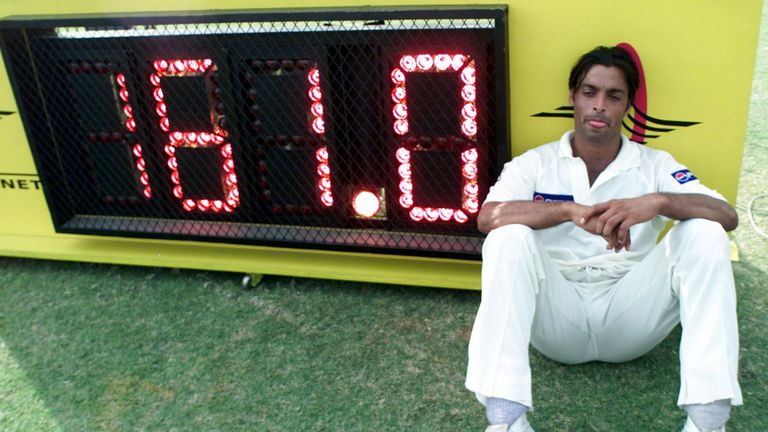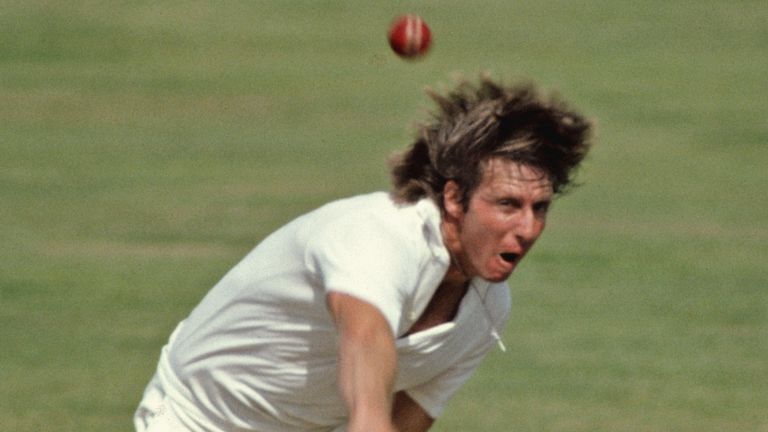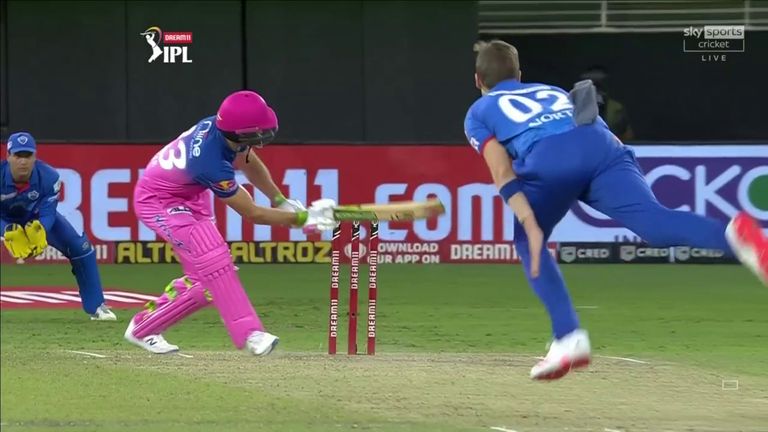Who is cricket's fastest-ever bowler? Benedict Bermange looks at the game's quickest seamers
Anrich Nortje bowled an IPL-record 97.1mph delivery to Jos Buttler
Friday 23 October 2020 09:34, UK
After Anrich Nortje bowled the fastest ball in the IPL, Benedict Bermange tries to decipher cricket's quickest-ever bowler...
For as long as cricket has been played, the physical battle between batsmen and fast bowler has been a key part of the spectacle.
Throughout the years there have been many claims as to who might have been the fastest bowler of all. There have even been competitions to try to discover who it might have been. So who was it? Or who is it? Or who might it have been?
In the early years, the pace of bowlers was generated primarily from hearsay. Fred Trueman himself claimed to be 'the greatest bloody fast bowler that ever drew breath'. But was he really?
Frank Tyson blew into Australia for the 1954/55 tour and garnered the nickname of Typhoon Tyson for the speed of his bowling.
A generation before Tyson, it was Harold Larwood who took his brand of firepower to Australia in the infamous 'Bodyline' series when he was reportedly measured at 96mph, although it is not clear exactly how that measurement was made.
The 1970s brought the first scientific attempts to measure speed and also brought Dennis Lillee and Jeff Thomson, who captured the public's imagination with their decidedly anti-establishment image and routed England on their 1974/75 tour.
The following year the baton was passed to the West Indies, whose battery of fast bowlers dominated the cricketing world for the next quarter of a century.
A roll call of those 25 years of fast-bowling talent is to recite a list of some of the greatest cricketers the game has ever seen. Roberts, Holding, Garner, Croft, Marshall, Walsh and Ambrose, not to mention a supporting cast featuring Daniel, Bishop, Patterson and Sylvester Clarke.
But how to measure the speed of a travelling cricket ball?
Speeds are measured at release, with the pace decreasing as the ball makes its way to the batsman. The speed of a ball delivered at 90mph would decrease to about 80mph before pitching, and then further to 72mph after hitting the pitch.
A radar gun measures speed by sending a radio wave reflected by the object along its path. In this case, it's a cricket ball. The gun receives this echo and applies the principle of the Doppler Effect (the change in wavelength or frequency of a wave as it approaches or moves away from the observer) and calculates the speed of the ball.
Alternatively, the Hawkeye system tracks the ball's speed from cameras positioned at different angles which can subsequently be used to project whether or not the ball would have hit the stumps.
In 1975 some 'very accurate high speed cameras' were positioned at the WACA in Perth to measure the speeds of fast bowlers. It was there that Jeff Thomson recorded his record speed of 99.7 mph, closely followed by Andy Roberts at 99.1 mph.
The next attempt to try to answer the question as to who was the fastest came in 1979 in Australia when Richie Benaud hosted a competition featuring 12 bowlers from around the world. They each bowled eight deliveries in a net and the fastest speed was measured by Dr Frank Pyke of the University of Western Australia:
Thomson retained his title as the fastest bowler whose speed had been reliably measured - his record standing a tantalising 0.3 mph short of the magical 100mph mark. Incredibly, he was to retain the record for nearly three decades.
It was the 2003 World Cup match in Cape Town when Shoaib Akhtar roared in to bowl to England's Nick Knight. The delivery did not look particularly special, as Knight nudged it for a single into the leg-side. However, the scoreboard then flashed up "100.2 mph". The barrier had been broken.
Not to be outdone, Brett Lee clocked 100.1 mph in an ODI against New Zealand at Napier in 2005 and his team-mate Shaun Tait followed suit with an identical 100.1mph in a 2010 ODI against England at Lord's. To this day those three remain the only bowlers to have reached three figures on the speed gun.
With science, sports medicine and biomechanics now analysing every aspect of the game, bowlers should surely be fitter, stronger and quicker than ever before. But is that the case? Certainly the modern quickie doesn't seem able to bowl significantly faster Jeff Thomson did in the 1970s.
There have been some near-misses, with Mitchell Starc reaching 99.7mph and Mitchell Johnson 97.4mph, while in the summer of 2020 England fans were treated to a battle of supremacy between Jofra Archer and Mark Wood.
This year the competition was won by Wood, who peaked with a delivery to Aaron Finch in the first T20I on measured at 95.1mph. Archer's fastest ball of the summer was a 'mere' 93.6mph delivered to David Warner in the same match.
And so to the latest record-breaker Anrich Nortje.
In the recent IPL match between Delhi Capitals and Rajasthan Royals he was clocked at 97.1mph, the fastest delivery in the history of the competition, surpassing his countryman Dale Steyn's previous record of 95.9mph set back in 2012.
With bowlers limited to just four overs in Twenty20 cricket, there has never before been such an opportunity to put together a short, sharp burst of speed in cricket history.
Since the current speed measuring system was established for the IPL back in 2012, 25 bowlers have been clocked at a speed of at least 150kph which equates to 93.2 mph. Here are the fastest 10 bowlers in that period of time, sorted by their fastest delivery:
With the IPL record under his belt, Nortje can now take aim at Shoaib Akhtar's world record, and at the age of 26, who would bet against him?
"Hopefully it's something I've got in me - it's definitely something I've wanted to do," Nortje said on his Delhi Capitals team-mate Ravichandran Ashwin's YouTube channel.
"Maybe a good wicket, some adrenaline, the right combination and I can do it this IPL or maybe in the future."
Watch Nortje in action for Delhi Capitals against Kings XI Punjab in the IPL live on Sky Sports Cricket from 2.50pm.








